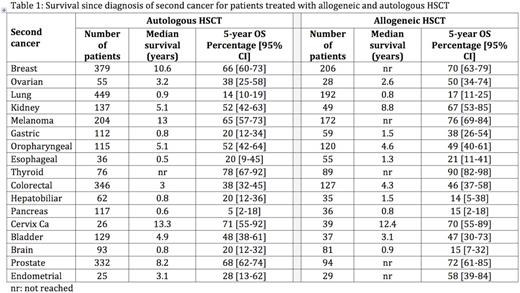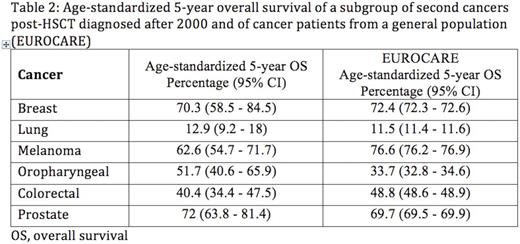Abstract
Background
Hematopoietic stem cell transplantation (HSCT) is potentially a curative treatment for a number of life-threatening malignant and non-malignant disorders. Despite significant improvements in outcome over time, long-term survivors are at risk for late complications and their mortality remains higher than expected. Second cancers are well-known late complications, associated with substantial mortality. Although we know the incidence and risk factors for many second cancers there is a paucity of data on their outcome after HSCT. We aimed to estimate the outcome of second cancers after HSCT using a large cohort of patients from the EBMT registry, and to compare their survival to similar cancers from a general population.
Method
This retrospective observational study was based on the mandatory minimum data set centers report to the EBMT. We identified all patients with second cancers (excluding malignant hematopoietic and lymphoid neoplasms; non-melanoma skin cancers) treated with HSCT in Europe (including Turkey and Israel), between 1977-2015. Primary diagnoses were acute leukemia (23%), chronic leukemia (9%), lymphoma (34%), plasma cell disorders (23%), solid tumors (4%), myelodysplastic syndromes and myeloproliferative neoplasms (6%) and acquired marrow failure syndromes (1%). For the different types of solid tumors, median and overallsurvival werecalculated (from time of diagnosis of the second cancer). Results were analyzed separately for patients treated with autologous and allogeneic HSCT (table 1). For six prevalent second cancers (breast, lung, melanoma, oropharyngeal, colorectal, prostate; table 2), the age-standardized 5-year overall survival (according to the International Cancer Survival Standard; ICSS) of HSCT patients with second cancer diagnosed since the year 2000 was compared to cancer patients from a general population (EUROCARE, European Cancer Registry, period 2000-2007).
Results
From the EBMT registry 4152 second cancers out of 220617 (1.88%) HSCT patients were extracted: 1450 (1.79%) out of 80784 patients after allogeneic, and 2702 (1.93%) out of 139833 patients after autologous HSCT. The median age of the patients at HSCT and at diagnosis of second cancer was 53 years (range 1.2-86) and 59 years (3.2-88), respectively. For allogeneic HSCT is was 46 years (1.2-73) and 54 years (3.2-77), for autologous HSCT, 56 years (1.7-86) and 62 years (4.5-88), respectively. The median follow-up time since transplantation of all patients was 121 months (range 5-409); it was 146 months (12-409) for allogeneic, and 114 months (5-354) for autologous HSCT. The median follow-up time since diagnosis of second cancer was 35 months (range 0-240); it was 38 months (0-240) for allogeneic, and 33 months (0-228) for autologous HSCT.
The distribution and survival outcomes of second cancers are shown on table 1. Overall survival following diagnosis of second cancers depends mostly on the type of cancer. No relevant differences in median survival and 5-year overall survival were seen between patients treated with autologous or allogeneic HSCT (table 1). For second breast, lung and prostate cancers no difference in 5-year overall survival wasobserved,compared to cancer patients from a general population (table 2). Melanoma and colorectal cancers had worse, and oropharyngeal cancer better overall survival, compared to the EUROCARE control group.
Conclusion
This large population-based analysis on second cancers among HSCT survivors showed that the outcome for patients developing a second cancer after HSCT is mainly dependent on the type of cancer. It seems that for a number of second cancer overall survival is comparable to cancer patients from a general population. A systematic comparison is now required for all post HSCT second cancers.
No relevant conflicts of interest to declare.
Author notes
Asterisk with author names denotes non-ASH members.



This feature is available to Subscribers Only
Sign In or Create an Account Close Modal